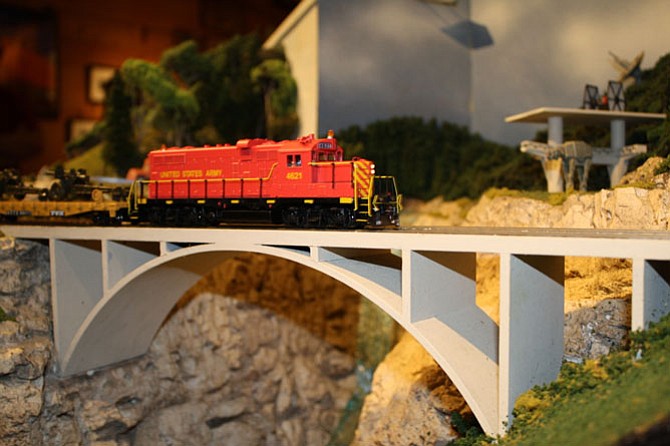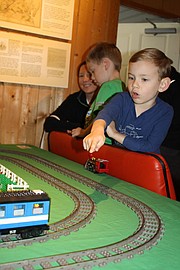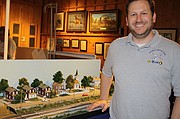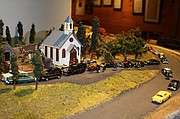This realistic bridge crosses a river. Photo by Mike Salmon.
Fairfax Station — To create the HO Scale train set up inside the Fairfax Station museum, it takes
10 straight modules and four corners, and the straight modules must be four feet long and two feet wide.
All the model train participants in the HO Gauge Model Train Show over the Labor Day weekend know the drill, and each built a different module in the set up, with themes ranging from Civil War to river crossings to a hometown scene from Pennsylvania.
“This is western Pennsylvania, like the world I grew up in,” said Nick Craven, as he pointed at his module with modern houses, a church and street with cars, just like a suburban setting. Craven, 35, is a member of the Potomac Module Crew and resident of Alexandria who lives near the railroad tracks on the northern end of Old Town, providing a soundtrack to his interest in railroads. “I’m right near the tracks going to the power plant, I can hear them all night,” he said.
THEY ALL GO for realism when it comes to modules. Jim Matthews’ module
depicts a funeral. He planned to feature a wedding, but “I found the hearse before I found a bride and groom,” he joked. At another show where his module was used, somebody mentioned the morbidity of a funeral, but “that’s life,” Matthews added.
Melissa Suek of Reston likes the fact that her son Vincent, 2, is getting into the trains. “It builds engineering skills, woodworking, budgeting, it teaches a lot of life skills. We have a lot of wooden trains at home,” she said.
And so the trains rolled on, circling the track across bridges, past villages, through the Civil War Battle of Vienna, and past the children who looked on from the tables edge. The HO Gauge Model Train Show at Fairfax Station was one of many held at the location throughout the year. At each show, the model trains vary in size from the micro sized trains, to N Gauge, O27 Gauge, and G Gauge where the G stands for Garden, and is the biggest model train.
The children are in awe as the cars go by on the tracks, and the older guys
control speeds with radio controllers. These are mostly retired men, which seem to be the demographic for this hobby. Children are into trains, refueled in the train world by the Thomas The Train books and cartoons, and the retired men are mostly revisiting a hobby they had when they were kids and have taken it back up.
“This is an old guys hobby, the hobby is aging,” said Tim Barr, one of the hobbyists from Manassas who comes to Fairfax Station for shows a few times a year. “I had them when I was a kid, didn’t get back into it until I retired,” he said.
“At 35 I believe I’m the youngest,” Craven added. He worked at a hobby shop in Blacksburg, Va. while he was enrolled at Virginia Tech so that helped re-ignite his interest in model trains.
Several are members of the National Model Railroad Association (NMRA) that sets the loose standards for model railroading. For example, there are two types of modules the NMRA says, and one is “Mainline,” and the other “Industrial.” The mainline modules are straighter and more level for longer and faster trains, while the industrial focuses on freight trains of sorts. “Secondary as it is so constructed as to allow certain grades and shorter radii such as is found in branch line and logging or industry areas,” the NMRA says.
Roger Boughton, from the Fairfax Station show, took the train last year from Springfield to the NMRA Annual Convention this summer in Orlando, Fla. At the convention, the manufacturers were showing advances in the hobby. Electronics and radio controls “are getting more sophisticated,” Boughton said. In 1976, the convention was in Washington, D.C. he said,
BACK AT THE TRACKS, staring at the trains going by, Andrew Blacker, age 4, is wide eyed. His father Bill knows the fascination. “We spend a lot of time in Lorton Station watching the trains,” he said.



